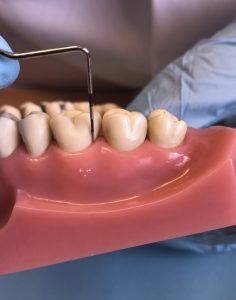One of the most dangerous health risks to your gums is a disease called periodontitis, a result of infection and inflammation. If left untreated, it can cause major dental damage, including recession of the gums, tooth loss, and even degeneration of the jaw bone. Worse yet, the bacterial infection that causes periodontitis has a chance of spreading throughout your body, even your heart and lungs!
Unfortunately, periodontitis is a risk most of us will contend with at least once in our lifetime. According to the Centers of Disease Control and Prevention (CDC), more than 45% of adults over 30 are infected with some form of periodontal disease. So it is no wonder why dental health professionals are looking for means to treat this condition quickly, effectively, and most importantly, non-surgically.
Why Non-Surgical Treatments?
Surgery is often seen as the peak of modern medicine, possibly due to the popularity of medical dramas. But it is important to note that when dealing with a disease that affects such a vast number of people, a “one size fits all” approach isn’t just impossible—it may even be irresponsible in some cases.
This is why the success of the non-surgical gum disease treatments has been hailed as revolutionary in the field of dentistry.
In fact, according to the American Academy of Periodontology (AAP), treatment of periodontitis should be both cost effective and as least invasive as possible. This makes sense when considering cortisol (often referred to as the “stress hormone”) is a major factor in your gums’ inflammatory response when dealing with gum disease. To achieve both the goals of cost effectiveness and least invasive procedures, surgery is not prioritized.
What Are the Non-Surgical Treatment Options?
If you have been diagnosed with gum disease or suffering from advanced stages of periodontitis, it is important that you meet with Dr. Hill and our hygiene team to learn all of your treatment options. However, there are two primary, non-invasive procedures recommended by the AAP that have proven to be the most successful.
Scaling and Root Planing
If you are suffering from periodontitis, it is more than likely scaling and root planing will be recommended by your dentist. This is due to the incredible accuracy that the two step procedure provides.
- The first step, known as scaling, will remove the plaque bacteria and tartar (also known as calculus) from the surface of your teeth as well as from underneath the gum line. To accomplish this, a variety of tools may be used, from an ultrasonic device that uses vibrations to shake unwanted material free and/or a traditional “scaler” which manually separates teeth from any harmful buildup.
- Following this step is the root planing. This process accesses any damage that may have occurred in the space between your tooth’s roots and gum line which aids in reattachment. Doing so will not only accelerate recovery, but can also save a tooth as its root surface system begins to function naturally once again.
- Many patients benefit from antibiotic therapy and follow-up examinations to document tooth, gum, and bone improvement. This is determined by Dr. Hill for each individual patient.
Tray Delivery Systems
Should you be diagnosed with chronic periodontitis, scaling and root planing might not be the best course of action. The treatment for persistent gum disease may come in the form of a tray delivery system—a dental procedure so straightforward that both the AAP and the Food and Drug Administration (FDA) have marveled at it.
Tray delivery systems are similar to the traditional dental trays that used fluoride which helped fight tooth decay. An impression of your mouth will be made (the tray), but instead of fluoride, medicine prescribed by your dentist will be used. The tray will make sure this medication reaches the most vulnerable spots of your mouth, eliminating gum disease at its source.
Guard Your Gums With Our Help!
 While it is encouraging to see how successful non-surgical procedures are when it comes to periodontitis, the best way to guard your gums is regular exams and routine dental cleanings! This will not only significantly lower your risk of gum disease but also allow dental professionals to monitor for any early warning signs like plaque buildup or inflammation.
While it is encouraging to see how successful non-surgical procedures are when it comes to periodontitis, the best way to guard your gums is regular exams and routine dental cleanings! This will not only significantly lower your risk of gum disease but also allow dental professionals to monitor for any early warning signs like plaque buildup or inflammation.
So, keep yourself safe and schedule your next consultation today.